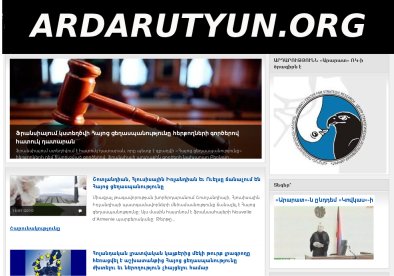|
choose language [english] [armenian] [russian] |
|

|
HOME :: ANALYSIS :: Artsakh
Caveat Emptor: Weak Negotiating Strategies and Settlement Pitfalls Author: Levon Chorbajian | Date: 10-07-2009 | 10-11 July 2009 Stepanakert Levon Chorbajian Department of Sociology University of Massachusetts Lowell I would like to thank the organizers for calling this conference at this timely moment. And I would especially like to pay my respects to the people of Karabagh and Armenia for courageously challenging Soviet and Azerbaijani authority and reversing the clear injustice of assigning this territory to the Azerbaijan S.S.R. in the early 1920s. The result is an independent Karabagh and it is a great achievement. I am not unmindful of the tremendous sacrifices that have been made and continue to be made to keep this reality afloat. My purpose is to call those sacrifices to mind and to argue that we should not participate in a process that would cause them to have been made in vain. I am not going to be entirely critical of Armenian diplomacy regarding Karabagh. It has had its successes. If it had not, we would not be able to be here. But I do want to say that Armenia and Karabagh have clear historical and ideological resources on their side which have not been put to full use or—even worse--put to any use at all. When Azerbaijan and Turkey negotiate, they negotiate from maximalist positions, and they are very reluctant to make concessions. Armenians do not seem to follow suit. Why have governments in Yerevan, for example, acted to assure Turkey that they have no claims on that nation, as though we were the guilty party and had, therefore, to reassure others of our good intentions? Concerning Karabagh, and also the opening of the Turkish border, I would say first that there has to be a recognition that Pan-Turkism is not a marginal ideology in Turkey or Azerbaijan. The Turks and the Azeris have their differences, but they have both long coveted Armenian territories to fulfill their ambition of an unbroken territorial link between them. This should not be underestimated, and what follows from this observation is that the Karabagh Question is not, as the Minsk Group insists, a narrow dispute limited to Nagorno-Karabagh. No, it is about Karabagh but also about the fate of Armenia and the Armenian people on an independent Armenian homeland. That is what is at stake. My focus is on bargaining strategies that I believe have not been effectively used by the Armenian side and need to be used. The first, and I will not have a lot to say about it because it has been noted by several previous speakers, is the exclusion of Nagorno-Karabagh from the negotiating process. This is the single greatest flaw in the negotiating process and, to my knowledge, without precedent in the history of conflict resolution. The second is that territorial claims have traditionally been decided on the basis of three criteria: 1) who has lived there historically?, 2) who lives there now?, and 3) what do the people who live there now want? It is actually unusual for all three of these to fall on one side. Consider the case of Northern Ireland, a colonized territory, but one where the Catholics are a minority in their own land and have been for a long time. But in the Karabagh case all three criteria do favor the Armenian side. I think this point that Karabagh presents one of the world’s strongest cases in favor of independence should be stressed repeatedly and there should be no compromise on it. The third issue concerns borders. The current borders of Nagorno-Karabagh are much smaller than the territory that Azerbaijan received in 1923. At that time Karabagh and Armenia shared a border. Territories were taken from Karabagh and from southern Armenia (Siunik was wider at that time than it is now) to form Red Kurdistan, and as soon as the goal of that change, which was never to territorially recognize the Kurds but rather to aggrandize Azeri territory, was accomplished, the Kurds were quickly abandoned and Red Kurdistan disappeared to became a part of Azerbaijan proper. The northern Armenian populated areas of Shahumian and others were also separated out of Karabagh and made parts of Azerbaijan itself. The transfer of parcels of land from Armenia and Karabagh to Nakhichevan and Azerbaijan continued into the 1930s. These territories transferred from Armenia to Azerbaijan included, but were not limited to, three mountain lakes near the village of Istisu and the villages of Istisu, Zar, and Zivel. Furthermore, Armenian villages in Kelbajar and the Lachin Corridor were, shall we say, ethnically cleansed. I think it is incumbent on Armenian negotiators to study maps from the 1920s and 1930s and document these changes, especially now that the fate of the occupied territories is still in the balance. The point must be forcefully and repeatedly made that the so-called occupied territories, at least those between Karabagh and Armenia are, in fact, Armenian and should remain so. And also that this is essential to the national security of Armenia and Karabagh. The fourth issue is that Azerbaijan repeatedly makes preposterous claims that Armenians do not confront and challenge, thereby lending them a credibility they do not deserve. The entire claim of Azerbaijani historians that the Azeris are descendents of the Caucasian Albanians and therefore a nation of longstanding with a prior claim to Karabagh is utterly baseless and false. It needs to be challenged rigorously whenever it is raised. Or let us consider the argument that Shoushi is an Azerbaijani city. It was briefly in the 18th century but part of the 18th century is a only a small slice of history. By 1900 Shoushi was the third largest city in the Transcaucasus after Baku and Tiflis and the majority of its nearly 40,000 inhabitants were Armenian. The Armenians of Shoushi operated a printing press, schools, and a theater complex. Of the 21 newspapers and magazines published in the city at the time of the Bolshevik Revolution, 19 were in Armenian and two in Russian. And consider how the Armenian city of Shoushi was turned into an Azeri city in March and April of 1920. The Armenian section of the city was destroyed by Azeri and Turkish forces and twenty thousand Armenians were killed. The ruins of these buildings stood as a silent testimony of Azerbaijani intentions until they were razed in the 1960s. The next point concerns international law. Whenever it is claimed that self-determination has a lesser standing in international law than the territorial integrity of national states, it should be aggressively pointed out, and correctly so, that this is not true. Their standing is unequivocally equal. On a related issue, the West insists that self-determination can only occur when it does not clash with territorial integrity, yet, in fact, the West supports the creation of new nation states whose independence does violate the territorial integrity of existing states. The West has recognized the former East Pakistan as Bangladesh, as well as Eritrea in the Horn of Africa, and now Kosovo. I think it is useful to confront western negotiators and to insist on answers to the questions why the double standard? And why not Karabagh? As I understand it the re-settlement of refugees is also a condition of settlement. Here Azerbaijan has benefitted by the West’s very narrow definition of this struggle as a struggle about Karabagh only instead of seeing it in its historical context as the latest phase of a struggle between Armenian national security and Turkish imperial ambition. Seen in this light, we should be able to understand that there are hundreds of thousands of Armenian victims and refugees, not only Azeri ones. Will Armenians who so desire be able to return to Baku and other parts of Azerbaijan and reclaim their properties and be able to live in peace or only Azeris from Karabagh and the liberated territories? There is a terrible imbalance here that ought to be pointed out. An offshoot of the refugee and re-settlement issue is what I call the demographic time bomb. Many Armenian families in Karabagh produce one, two, or three children while many Azeri families produce five, six, or seven. I do not have a solution for this, but I point out that even in the best of settlements, the Armenian population of Karabagh will be diminished over time rather quickly as was already happening prior to 1988. Has the Armenian side given proper attention to the implications of the re-settlement of Azeris, at least in Karabagh, Kelbajar, and the Lachin Corridor? Finally, I have alluded to national security issues for Armenia and Karabagh, and I wish to say a few more words about them. These are essential considerations for the future of the Armenian people if we are not to become the equivalent of a South African bantustan under the apartheid regime. I point out that Armenian national security is not the primary consideration of any parties to the conflict or the settlement except Armenians. The West wants a quick fix to enable the flow of investment and commerce, and to protect its oil investments and pipeline flows. And certainly not Turkey and Azerbaijan. So Armenians need to insist that any international peacekeeping forces be adequate in number, fully funded and for the long term. On the basis of the tremendous expense alone, the West resists this, and this is not to the advantage of Armenians. I will conclude with these two points. The first is that the territories are the only real leverage that Armenians have. There cannot be any workable settlement of the Karabagh Question that surrenders territory without the declaration and international recognition of an independent Karabagh with defensible borders. The second point concerns Azerbaijan’s most generous offer to date: the return of territories for the promise of the highest degree of autonomy for Karabagh within Azerbaijan. Armenia and Karabagh should never waver from the position that this is not good enough. After all, de jure autonomy is exactly what Armenians had in the Ottoman Empire in 1915. References Most of this material is taken from four books which themselves contain many references to primary and secondary source materials. Those who wish to do so may consult these for those references. Armen Aivazian, “Possible Solutions to the Nagorno-Karabagh Problem: A Strategic Perspective” in Levon Chorbajian, ed., The Making of Nagorno-Karabagh: From Secession to Republic. Basingstoke, U.K.: Palgrave, 2001. Levon Chorbajian, Claude Mutafian, and Patrick Donabedian. The Caucasian Knot: The History and Geopolitics of Nagorno-Karabagh. London: Zed Books Ltd., 1995. Rouben Galichian. The Invention of History: Azerbaijan, Armenia, and the Showcasing of Imagination. London: Gomidas Institute, 2009. Shahen Mkrtchian and Shchors Davtian. Shoushy: The City of Tragic Fate. Yerevan: Gasprint, 2008. |
|
all rights reserved 2007-2013 site designed and developed by Impresario Productions & "Ararat" Center
Yerevan, Ayguedzor Imp. 10, E-mail: info @ ararat-center.org
|
|
|
|
|

